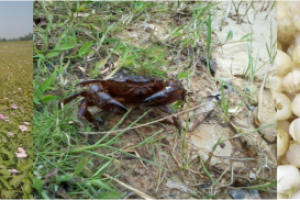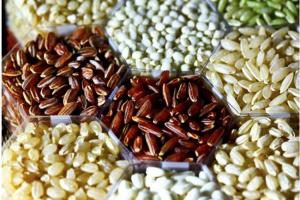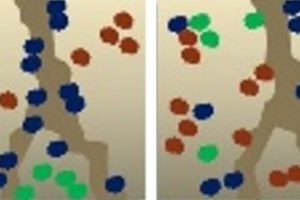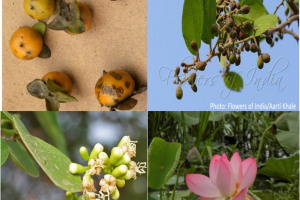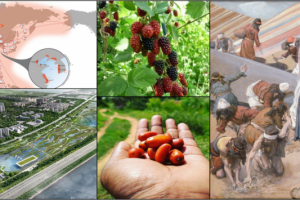EDITORIAL
 Hello readers, CEiBa team is happy-presenting the 2nd issue of the newsletter for the year, 2019.
Hello readers, CEiBa team is happy-presenting the 2nd issue of the newsletter for the year, 2019.
Six issues of the newsletter are out and it turned one and a half years now. One primary aim of the newsletter is to tell about the fascinating realms of the natural world to the readers who represent all sections of the society. Our authors and team members work relentlessly to keep the contents simple, easy-digesting yet scientifically correct. We anticipate our newsletter will fill up the pervasive gap between science and the society and will receive applause from our readers.
With this in mind, this time our article section starts with ‘Food from patallok’. The literary meaning of ‘patallok’ is underworld or in a coarse term underground. Against the backdrop of flood-prone Kosi river basin in North Bihar, local economically down-trodden people are heavily dependent on diverse underground life forms for their food supply in lean season and as an alternative nutrition resource. A field researcher’s first-hand account on these traditional practices describes the natural resource diversity and people’s adaptive power to explore and exploit it. In continuation, our second article is also on food but covering one of the important but under-explored component of modern day food chain, the consumers or buyers. Unbelievable may be, but food consumers are one of the prime factors responsible for shaping up agro-biodiversity. It is the preference for certain food which partly prompts agriculture production, intensification, and homogenization; on the other hand, the same customers’ desire for unique and rare types also influences local agri-flora and fauna conservation. Our second article describes this complex and conflicting topic with rice as an example. It dabbles in Basmati to Palghat Matta, high-yielding varieties to local landraces, 5-star hotels to farmers’ house, and agriculture to cultural practice to give us a flavor of consumer-driven angle of rice diversity. Next in line is an article on forest ecosystem. Majority of us perceives forest as a place with uninterrupted distribution of trees. For ecologists, this apparent tranquility poses a series of questions on the underlying laws of distribution. What are the driving factors behind the pattern of plant distribution? Is it solely dependent on environment? Seed dispersal? Competition for resources or chance factors? This article narrates this inside story of the tropical forest through a learner’s perspective. Hope our next visit to the forest will be more meaningful and enjoyable.
In wild food section, members like Nelumbo sp, Diospyros sp., Ziziphus sp. and Cordia sp. with their diverse foody sides made their place. Many of which were in regular diet even a generation ago, but they have disappeared from our plate as well as from market. We hope that, readers can recall some of the dishes and resurrect the link with these unconventional foods described through vivid descriptions, images, and associated food maps.
Coming to the end, snippets on dark diversity, bird airport, floating guava market, superfood of the Bible – Manna, and wild food of Bengaluru are also crowding the readers-basket.
So, welcome and have a very happy reading.
RAJASRI RAY
ARTICLES
Food from the Paataal Loke – fishing apple snail, field rats and more in the Sickle Economy
North Bihar is a flood-prone region and every village and Mohalla in this region is either bisected by small and big rivers flowing from the Nepal Himalaya or surrounded by ponds and wetlands locally known as chaurs. The communities living in the Kosi villages are mainly dependent on agriculture and fishing. When there is no work at agricultural fields, men from most of the lower caste communities including Musahar and Mallah, two of…
White, shiny, aromatic and more…signals of finesse and identity – How consumer choice affects agricultural biodiversity?
Agro-biodiversity, bewildering types of agricultural crops and their visible and invisible features, is central to our sustainable food system. Like biodiversity, there are many players that crafted the rich spectra of cultivated crops. Human agency has been at the focal point in multifarious forms and capacities. One such key player in the origin of crop diversity has been the choice of consumers or crop eaters, who used to select the specific type(s) of…
The hidden structure of tropical forests
Humans seem to constantly seek patterns, and their explanations, in nature, even when doing so has no obvious intrinsic value. Many years ago, I walked around in a tropical forest, overwhelmed by the complexity around me. I wondered to what extent there was order, some underlying explanation as to why each plant was where it was, and to what extent the placement of plants was random. Have you ever wondered too –…
WILD UNCULTIVATED EDIBLE PLANTS OF INDIA
WILD UNCULTIVATED EDIBLE PLANTS OF INDIA
Part 2 (……after part 1) Nelumbo nucifera Family: Nelumbonaceae A perennial aquatic herb boasting soft pink flowers does not only soothe our eyes but also fills up our stomach with all edible parts. Like it’s ubiquitous distribution in the stagnant water bodies across the country, it’s culinary tradition is diverse as well. Starting from distant north-eastern state of Manipur, locally known as ‘thambal’ or ‘thamau’ the plant is widely available in local…
GLIMPSES OF NATURE AND CULTURE
Glimpses Of Nature And Culture
An airport for feathery flyers We heard about birds hitting the aircraft, occupy the runway even there are drones to divert them but having an airport for them is beyond our imagination. However, it seems to be true in other sense in China. Tianjin city council along with Asian Development Bank (ADB) and McGregor Coxall (Designer and Landscape Architects) is planning to develop a giant natural reserve (Lingang Bird Airport) near the…

